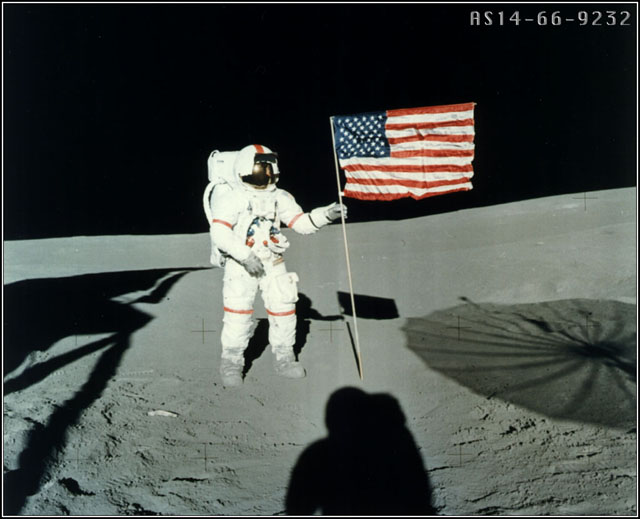The Apollo 14 mission was the third manned lunar landing mission. Its objective was to perform detailed scientific lunar exploration. The space vehicle with a crew of Alan B. Shepard, Jr., the commander; Stuart A. Roosa, the command module pilot; and Edgar D. Mitchell, the lunar module pilot, was launched from Kennedy Space Center, Fla., at 4:03:22 EST on January 31, 1971.
The touchdown occurred at 08:37:10 GMT, February 5, within 50m (160 ft) of the target point in the Fra Mauro highlands. The first extravehicular activity (EVA) began 5 hr 23 min after touchdown.
A color television camera mounted on the descent stage provided live coverage of the descent of both astronauts to the lunar surface. The crew deployed the U.S. flag and and the solar-wind composition experiment, erected the S-band antenna, and off-loaded the modularized equipment transporter (MET), laser ranging retroreflector (LRRR), and the Apollo lunar-surface experiments package (ALSEP).

The second EVA was a planned extended geological traverse of Cone Crater. All equipment required for the geological traverse, including the lunar portable magnetometer (LPM), was loaded on the MET. The traverse up the side of Cone Crater provided experience in climbing and working in hilly terrain in 1/6 earth gravity conditions. This EVA lasted 4 hr and 20 min, during which time the astronauts traveled approximately 3 km.

Liftoff occurred at 18:48 GMT, February 6, after 33 hr on the lunar surface. After crew transfer, the LM ascent stage was separated and remotely guided to impact on the lunar surface. Impact occurred between Apollo 12 and 14 seismometers. The resulting seismic signal lasted for 1.5 hr and was recorded by both instruments.
The command module splashed down in the Pacific Ocean approximately 1 km from the target point at 20:24 GMT, February 9, 1971.


 Apollo 14 landed in the Fra Mauro region, the intended landing site of the aborted Apollo 13 mission. The astronauts used the Modularized Equipment Transporter (MET) to haul equipment during two EVAs (later missions would use the Lunar Roving Vehicle). They collected samples, took photographs, and the nearby Cone crater. One of the more famous moments came at the end of the second EVA when Apollo 14 commander Alan Shepard hit 2 golf balls on the Moon.
Apollo 14 landed in the Fra Mauro region, the intended landing site of the aborted Apollo 13 mission. The astronauts used the Modularized Equipment Transporter (MET) to haul equipment during two EVAs (later missions would use the Lunar Roving Vehicle). They collected samples, took photographs, and the nearby Cone crater. One of the more famous moments came at the end of the second EVA when Apollo 14 commander Alan Shepard hit 2 golf balls on the Moon.





